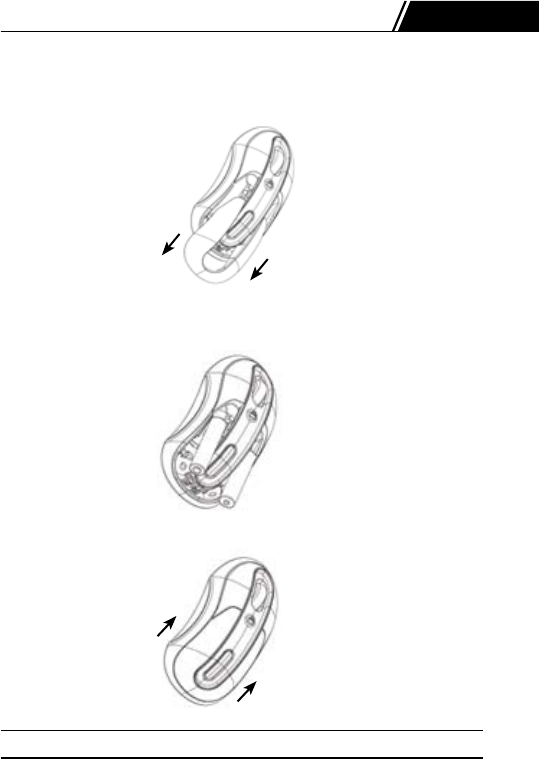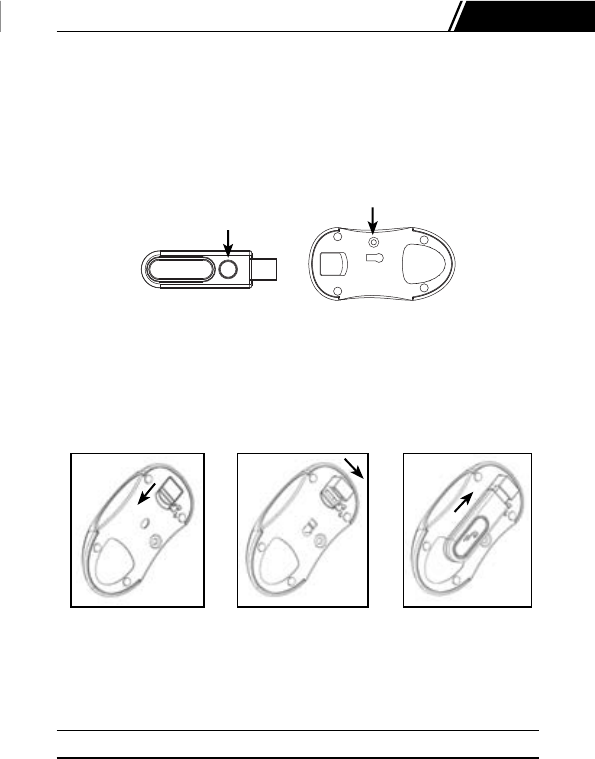KYE SYSTEMS KM001 Optical Mouse User Manual
KYE Systems Corp Optical Mouse Users Manual
Users Manual

1
▼ Introduction
Congratulations on your purchase of a rocketsh 27MHz Wireless Optical Mouse. This
ergonomically designed mouse uses a radio frequency (RF) link that enables you to use
the mouse anywhere within distance of its receiver. No line-of-sight between the mouse
and its receiver is required. In addition to this user’s guide this package contains:
• Mouse
• USB receiver
• 2 AAA batteries
• Carrying pouch
▼ System Requirements
Hardware
• PC with a Pentium® processor or the equivalent
• USB interface
Operating System
• Windows® 98SE/Me/2000/XP and Mac
▼ Connecting the Mouse Receiver
To connect the mouse receiver:
1. Plug the USB receiver into an available USB port on your computer.
2. Your computer’s operating system identies the receiver and begins installing the
default driver.
3. Follow any on-screen procedures to complete the default driver installation.
English

2
▼ Using the mouse
Install the batteries
a. Press the battery releasing button to open battery cover.
b. Insert batteries, making sure that the positive (+) and negative (-) ends of each battery
match the polarity indicators inside the battery housing.
c. Put on the battery cover.
English
+
_
_
+

3
▼ Establishing a communications link
The mouse has 256 identication codes that allow the mouse and its receiver to operate
without interference from other radio frequency devices.
After your computer detects the USB receiver and the driver is installed, you must establish
a communications link between the mouse and its receiver BEFORE you can use the
mouse. To do this, follow the instructions below:
1. Press and release the link button located on the receiver.The receiver’s status light
blinks when the receiver is activated.
2. Press and release the link button, located on the bottom of the mouse, and you are now
ready to use the mouse.
▼ Mouse Power Management
a. Push back the lock of dongle holder.
b. Pull the dongle holder till the end to power off
c. Insert receiver to the dongle holder while travelling.
d. The mouse will go into “sleep mode” after 7 minutes of idling status.
To awake the mouse, just move or click any key of the mouse.
e. While power is running out, the LED light will turn to RED with blinking light.
English
Link Button
abc
Link Button

4
▼ Operating hints
For optimal performance and RF reception:
• Place the receiver at least 8 inches (20 cm) away from all electrical devices, such
as your monitor, speakers or external storage devices. If necessary, use the
extension cable to keep the receiver away from the computer. Plug the receiver into the
extension cable, and the extension cable to the computer.
• Avoid using the mouse on a metal surface. Metals, such as iron, aluminum or copper,
shield the radio frequency transmission and may slow down the mouse’s response time
or cause the mouse to fail temporarily.
• The mouse will enter a suspend mode at the same time your computer does. To activate
the mouse, simply move or click the mouse.
• If your computer has a metal case that contains aluminum or magnesium, use the
mouse to the side. The display panel may interfere with the radio frequency signal if you
use the mouse directly in front of the computer.
• Never use the mouse on a glass or mirrored surface as these surfaces will cause the
mouse to fail temporarily.
• To maximize battery life, use the mouse on a white, or light colored surface. Dark
surfaces cause the mouse’s light emitter diode (LED) light to glow brighter, which causes
the battery to discharge more rapidly.
▼ Comfortable usage
Research suggests that physical discomfort and injury to nerves, tendons, and muscles
may be related to repetitive motion, an improperly set up work area, incorrect body
posture, and poor work habits.
To reduce the risk of injury, follow these precautions:
• Stand, stretch, and move around several times every hour.
• Switch hands while performing tasks. Use shortcut keys to avoid repetitive or awkward
mouse movements.
• Relax your shoulders and keep your elbows at your sides. Adjust the keyboard’s
position so that you don’t have to stretch to reach it.
• Adjust your position so that you don’t have to bend your wrists to type; avoid placing
your wrists on a sharp edge.
• If you feel discomfort or numbness in your hands, wrists, arms, shoulders, neck, or back
while typing, consult a qualied medical professional.
English

5
English
▼ Specications
Interface
Radio Frequency
Working Distance
Working Principle
CMOS Sensor
Resolution
Tracking Speed
Buttons
Wheel
Power Switch
Battery
Dimensions
Warranty
Operating Voltage
Operatig Current
USB Low Speed Device HID Class
27 MHz
More than 80 cm
Optical CMOS sensor
Agilent ADNS-5030
Optical resolution1000 cpi
14 ips
2 buttons plus roller button
1 scrolling wheel
Yes
1.5V AAA size x 2 PCs
W 54.6mm x H 36mm x L 105mm
1 year
1.6V~5V
26mA or lower
Interface
Radio Frequency
Dimensions
Warranty
Operating Voltage
Operatig Current
USB Low Speed Device HID Class
27 MHz
W 20mm x H 10mm x L 710mm
1 year
5V (Powered by the USB Port)
Below 15mA
RF Optical
Recevier

6
English
▼ Troubleshooting
What do I do if the mouse does not work?
• Make sure that the polarity of the batteries is correct. The positive (+) and negative
(-) ends of each battery must match the positive (+) and negative (-) connections in the
battery housing.
• Check that the receiver’s USB connector is rmly attached to the USB port on your
computer.
• Verify that the device drivers are installed.
• Make sure you have established a radio link between the mouse and its receiver.
When I use the mouse, other wireless devices work more slowly or fail
temporarily – what should I do?
The mouse may cause interference with any cordless, radio-based device that operates
at 27 MHz, such as a telephone, baby monitor, or toy. To reduce interference, move the
mouse’s receiver and the base unit of the affected device as far away from each other as
possible.
What do I do if the response time of the mouse is slow or the mouse
intermittently stops working?
• Increase the distance between the mouse’s receiver and the rest of your computer
equipment.
• Increase the distance between the mouse’s receiver and the base units of other wireless
devices.
• Turn off any wireless devices and their base units that are near the mouse’s receiver.
• If you are using the mouse on a metal surface, move it and the receiver to a non-metal
surface. Metals, such as iron, aluminum or copper, shield the radio frequency
transmission and may slow down the mouse’s response time or cause the mouse to fail
temporarily.
I can’t use the mouse while another RF mouse is inuse – what should I
do?
• Reset the identication code. See “Establishing a Communications Link” .

7
English
▼ FCC statement
United States Regulatory Information
This device complies with part 15 of the FCC Rules. Operation is subject to the following
two conditions: (1) This device may not cause harmful interference, and (2) this device
must accept any interference received, including interference that may cause undesired
operation.
▼ ICES-003 statement
Canadian Regulatory Information
This Class B digital apparatus complies with Canada ICES-003. Operation is subject to
the following two conditions: (1) This device may not cause harmful interference, and (2)
this device must accept any interference received, including interference that may cause
undesired operation.
▼ RSS-310 Statement
Operation is subject to the following two conditions: 1) this device may not cause
interference and 2) this device must accept any interference, including interference that
may cause undesired operation of the device
▼ Radiation Exposure Statement:
This equipment complies with IC radiation exposure limits set forth for an uncontrolled
environment. To maintain compliance with IC RF exposure compliance requirements,
please follow operation instruction as documented in this manual.
This equipment has been tested and found to comply with the limits for a Class B digital device, pursuant to part 15 of the
FCC rules. These limits are designed to provide reasonable protection against harmful interference in a residential
installation. This equipment generates, uses and can radiate radio frequency energy and, if not installed and used in
accordance with the instructions, may cause harmful interference to radio communications. However, there is no
guarantee that interference will not occur in a particular installation. If this equipment does cause harmful interference to
radio or television reception, which can be determined by turning the equipment off and on, the user is encouraged to try
to correct the interference by one or more of the following measures:
-Reorient or relocate the receiving antenna.
-Increase the separation between the equipment and receiver.
-Connect the equipment into an outlet on a circuit different from that to which the receiver is connected.
-Consult the dealer or an experienced radio/TV technician for help.
This device complies with Part 15 of the FCC Rules. Operation is subject to the following two conditions:
(1)•This device may not cause harmful interference.
(2)•This device must accept any interference received, including interference that maycause undesired operation.
Any changes or modifications (including the antennas) made to this device that are not expressly approved by the
manufacturer may void the user’s authority to operate the equipment.